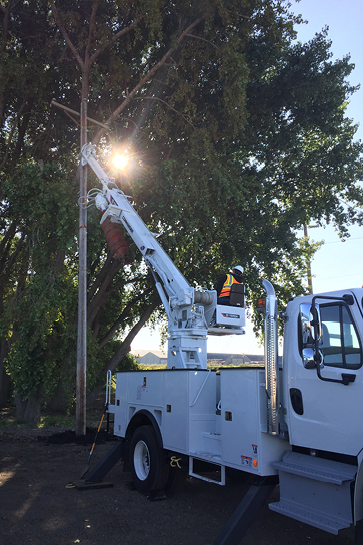Digger Derricks: Among the Most Versatile Tools – When Used Correctly
Digger derricks are built to tackle a myriad of tasks ─ from digging holes then lifting and setting poles to turning in screw anchors, putting linemen in the air, and setting transformers. Like the people who use them, digger derricks are hard working tools used to solve a variety of challenges.

True or False: You can use a digger derrick boom to rock a pole loose or use the load line to forcibly remove the pole.
The Answer? FALSE. This practice is prohibited by manufacturers because it can impose unknown loads and forces that key components were not designed to withstand. It can also result in the pole breaking causing injury.
With this tool’s versatility, there are work practices that need to be properly managed, such as removing and setting poles. If not done properly, equipment can be damaged.
Top Tips for Removing Poles
Don’t Rely Solely on a Digger’s Brute Force
Digger derrick work practices for removing poles must be properly managed to prevent damage. The main components of a digger derrick that can experience damage due to pole rocking include pedestal, turntable, boom, cylinders, pole guides, subframe, outriggers and winch. All these components are expensive to repair or replace if damaged. Downtime for repairs can put equipment out of service for extended periods.
Use a Pole Puller
Instead of using the boom’s brute force, a pole puller must be used to loosen the pole. Attempting to lift a pole that is frozen to the ground or embedded/fastened to the ground could shock load and cause an overload to the digger derrick components. Instead use a pole puller, which can provide much higher force to loosen the pole.
In extreme cases, it may be necessary to dig one or more holes with the digger derrick auger alongside the pole to loosen the soil, assisting the pole puller.
Correctly Lift the Pole
Once the pole is loose, then the lift cylinders can be used to carefully lift the pole until it is freely suspended, while using the pole guides to maintain control of the pole.
The actual lifting should only be done within the lift cylinder capacity, the load chart, and the number of parts of line – do not use the pole guides to lift the pole. The pole guide should only be used to help control the pole as it is being lifted.
The rigging attaching the pole to the load line must be above the balance point of the pole to keep the butt end heavy and down.
As the pole is lifted, it is always critical to maintain control of the pole. Shifting loads, misuse, or losing control of the pole can cause boom damage, pole guide, load line or rigging failure resulting in unpredictable movement of the pole. Losing control of the pole may lead to serious injury or death along with shock loading, side loading, and component damage or failure.
Pole Setting Reminders
Setting a pole with a digger derrick, in most cases, creates fewer chances for causing damage to equipment than when removing poles. However, these reminders are intended to help prevent damage to equipment.
The load line must be attached above the balance point of the pole and all components on the pole.
Never use the pole guides to support the pole. Pole guides are meant to help guide the pole, to keep it under control. Proper use will reduce the chances of damage by side loading or shock loading to the boom and damage to the pole guides themselves.
In some cases, alternate equipment might be necessary for digging the hole in the first place. The type of equipment used is dictated by the ground conditions that need to be augered. Proper selection of the auger will increase productivity. For example, in hard rock areas a core barrel can be used instead of a standard auger to increase productivity. Areas of shale require different types of tooling than sandy or clay soil conditions. Knowing which tools to use and having those tools available can save the operator countless hours, reduce wear, and tear on the equipment, and extend the life of the auger and teeth. Read more about Choosing the Right Auger Tooling for Your Digger Derrick here.
Related Posts

Safety Minute: 5 Tips for Safe and Productive Drilling with Your Digger Derrick
To stay safe and perform the job efficiently, utility crews make many important decisions when performing drilling operations. Here are 5 tips to follow for safe and productive drilling with your digger derrick.
Continue Reading

Three Important Tips on Conducting Your Own Annual Inspections on Bucket Trucks and Digger Derricks
While conducting your own annual inspections may seem the most affordable option, be sure to consider whether your technicians have the expertise required for the specific equipment. The same is true if you choose to outsource the inspection. If you are hiring someone else to do the inspection for you.....
Continue Reading

Choosing the Right Auger Tooling for Your Digger Derrick
To get the best performance out of your digger derrick, it is important to choose the right auger tooling for the job. Tools are interchangeable between different OEMs, but that doesn’t mean that all tools are created equal. Terex is the only...
Continue Reading

.png?sfvrsn=cfc0900d_0)